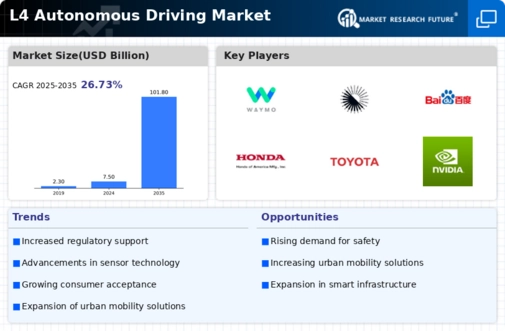Regulatory Frameworks
The establishment of comprehensive regulatory frameworks is a crucial driver for the L4 Autonomous Driving Market. Governments are increasingly recognizing the potential benefits of autonomous vehicles, leading to the formulation of policies that support their deployment. As of October 2025, several countries have enacted legislation that outlines safety standards and operational guidelines for L4 autonomous vehicles. This regulatory clarity not only fosters innovation but also instills confidence among manufacturers and consumers. The presence of supportive regulations is expected to facilitate the testing and commercialization of autonomous technologies, thereby accelerating market growth. Moreover, collaboration between public and private sectors is likely to enhance the development of infrastructure necessary for the widespread adoption of L4 autonomous driving.
Consumer Demand for Safety
Consumer demand for enhanced safety features is a significant driver in the L4 Autonomous Driving Market. As awareness of road safety issues increases, consumers are seeking solutions that can mitigate risks associated with human error. L4 autonomous vehicles, equipped with advanced safety systems, are perceived as a viable solution to reduce accidents and fatalities. Market data indicates that approximately 90% of traffic accidents are attributed to human error, underscoring the potential impact of autonomous technology. As of October 2025, the demand for safer transportation options is likely to propel the adoption of L4 autonomous vehicles, as consumers prioritize safety in their purchasing decisions. This trend is expected to encourage manufacturers to invest in research and development, further enhancing the safety features of their autonomous offerings.
Technological Advancements
The L4 Autonomous Driving Market is experiencing rapid technological advancements that are reshaping the landscape of transportation. Innovations in artificial intelligence, machine learning, and sensor technologies are enhancing the capabilities of autonomous vehicles. For instance, the integration of LiDAR and advanced computer vision systems allows vehicles to perceive their environment with unprecedented accuracy. As of October 2025, the market is projected to grow at a compound annual growth rate of approximately 25%, driven by these technological breakthroughs. Furthermore, the development of robust software platforms that facilitate vehicle-to-everything (V2X) communication is likely to enhance safety and efficiency, making L4 autonomous vehicles more appealing to consumers and businesses alike.
Urbanization and Traffic Congestion
The increasing rate of urbanization and the resultant traffic congestion are pivotal factors driving the L4 Autonomous Driving Market. As urban populations swell, cities are grappling with the challenges of traffic management and pollution. L4 autonomous vehicles offer a potential solution by optimizing traffic flow and reducing congestion through intelligent routing and coordination. As of October 2025, it is estimated that urban areas will account for over 70% of the global population, intensifying the need for innovative transportation solutions. The ability of L4 autonomous vehicles to communicate with each other and with traffic management systems may lead to more efficient use of roadways, thereby alleviating some of the pressures associated with urban traffic. This trend is likely to stimulate investment in autonomous technologies as cities seek to modernize their transportation infrastructure.
Environmental Sustainability Initiatives
Environmental sustainability initiatives are increasingly influencing the L4 Autonomous Driving Market. As concerns about climate change and air quality intensify, there is a growing emphasis on reducing carbon emissions from transportation. L4 autonomous vehicles, particularly those powered by electric or alternative energy sources, are seen as a key component in achieving sustainability goals. Market projections suggest that the adoption of electric L4 vehicles could reduce greenhouse gas emissions by up to 50% compared to traditional vehicles. As of October 2025, many governments are implementing policies that incentivize the use of autonomous electric vehicles, further driving market growth. This alignment with sustainability objectives is likely to attract investment and foster innovation within the L4 autonomous driving sector, as stakeholders seek to contribute to a more sustainable future.


















Leave a Comment